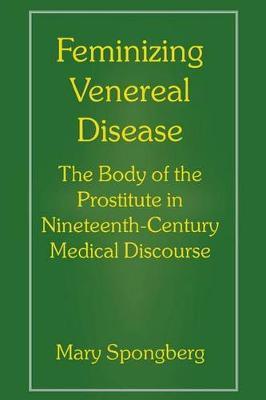Overview
In 1497 the local council of a small town in Scotland issued an order that all light women--women suspected of prostitution-- be branded with a hot iron on their face. In late eighteenth- century England, the body of the prostitute became almost synonymous with venereal disease as doctors drew up detailed descriptions of the abnormal and degenerate traits of fallen women. Throughout much of history, popular and medical knowledge has held women, especially promiscuous women, as the source of venereal disease. In Feminizing Venereal Disease, Mary Spongberg provides a critical examination of this practice by examining the construction of venereal disease in 19th century Britain. Spongberg argues that despite the efforts of doctors to treat medicine as a pure science, medical knowledge was greatly influenced by cultural assumptions and social and moral codes. By revealing the symbolic importance of the prostitute as the source of social disease in Victorian England, Spongberg presents a forceful argument about the gendering of nineteenth- century medicine. In a fascinating use of history to enlighten contemporary discourse, the book concludes with a compelling discussion of the impact of Victorian notions of the body on current discussions of HIV/AIDS, arguing that AIDS, like syphilis in the nineteenth century, has become a feminized disease.
Full Product Details
Author: Mary Spongberg ,
Paul Vanderham
Publisher: New York University Press
Imprint: New York University Press
Dimensions:
Width: 15.20cm
, Height: 2.40cm
, Length: 22.90cm
Weight: 0.454kg
ISBN: 9780814780602
ISBN 10: 0814780601
Pages: 240
Publication Date: 01 January 1997
Audience:
College/higher education
,
Professional and scholarly
,
Undergraduate
,
Postgraduate, Research & Scholarly
Format: Hardback
Publisher's Status: Active
Availability: Manufactured on demand

We will order this item for you from a manufactured on demand supplier.
Reviews
Did the artistic aspirations of Ulysses make its salacious parts any less salacious? This work of scrupulous scholarship is an entertaining and important book that traces the fascinating historical details behind the Ulysses trials. It shows that judge Woolsey's famous decision was based on testimony by experts who were calculating, fuzzy, and illogical. Vanderham exposes some of the facile pieties about Art that have prevailed in the academy and the courts ever since. His analysis has important implications for the law, helping us see that such judicial decisions should have a different basis altogether. -E. D. Hirsch, Jr., author of Cultural Literacy: What Every American Needs to Know
An interesting book for anyone who is interested in the history of venereal disease. It provides some interesting facts to consider about women and venereal disease and makes the reader aware that women have taken a bad rap for many centuries and that bad rap is slowly being transferred to the gays in this age of AIDS. Recommended for all academic and medical libraries. -AIDS Book Review Journal
<p> An interesting book for anyone who is interested in the history of venereal disease. It provides some interesting facts to consider about women and venereal disease and makes the reader aware that women have taken a bad rap for many centuries and that bad rap is slowly being transferred to the gays in this age of AIDS. Recommended for all academic and medical libraries.
(<p> An interesting book for anyone who is interested in the history of venereal disease. It provides some interesting facts to consider about women and venereal disease and makes the reader aware that women have taken a bad rap for many centuries and that bad rap is slowly being transferred to the gays in this age of AIDS. Recommended for all academic and medical libraries. )-( AIDS Book Review Journal ), ()
Author Information
Mary Spongberg is a lecturer in women's history at Macquarie University in Australia.




